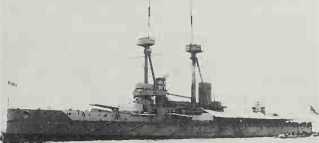
Vanguard: tragically destroyed, 1917
Stern. An accident delayed her completion until 1946. She was broken up in 1960. Because the elderly 15in mounting was so good, the 51,420-ton Vanguard proved an excellent ship, although she never saw action. DJL.
Vann, Lt Col John Paul (19241972). US. Military adviser to the ARVN 7th Division when it performed with cowardice in its disastrous defeat at Ap Bac, January 1963. Unlike his superiors, who downplayed the arvn’s deficiencies, Vann openly complained about them. The dispute personified the tension between informed advisers in the field and the official optimism of senior officials. Vann questioned the ability of the Saigon regime to make necessary reforms and decried the use of heavy fire power in a war that called for discriminating, politically sensitive tactics.
After trying unsuccessfully to argue his case in Washington, Vann returned to Vietnam as a civilian official of the Agency for International Development, eventually becoming senior American adviser in arvn II Corps in May 1971. He died in a helicopter crash, June 9 1972. WST.
Van Tien Dung, Senior General
(b. l917). Democratic Republic of Vietnam. Without any formal military training. Dung organized and commanded the 320th Division of the People’s Army of Vietnam (pavn) in the war with France. In 1953 he became pavn cos. After long service in the shadow of Vo Nguyen Giap, in 1980 he replaced Giap as Minister of National Defence and senior military member of the Communist Party Political Bureau.
Dung had a large hand in turning the PAVN into a modern conventional army during the Vietnam War, but he is best known for taking personal command of the offensive that brought the war to an end in 1975. For the opening attack on Ban Me Thuot, he chose the “blooming lotus tactic” of bypassing the city’s defensive perimeters then exploding outwards, which he claimed to have pioneered in an attack on the town of Phat Diem in 1952. WST.
Van Tuong peninsula. Battle of
(1965). US Marines chose the Van Tuong peninsula, located 15 miles (25km) south of their major base at Chu Lai, for the site of their first major operation in the Vietnam War. The peninsula contained three villages, one named Van Tuong, that had long concealed communist forces. In 1965, these forces consisted of the 2,000-man 1st Regiment of the plaf, and it was to find and destroy this regiment that the Marines launched Operation “Starlight” on August 18. With 6,000 troops supported by air, artillery, armour and naval bombardment, the Marines pinned the PLAF against the sea. Bitter fighting left 45 Marines dead and 203 wounded along with 599 bodies (or 700 or 964, depending on the source) that the Marines claimed to be plaf combatants. The success of “Starlight” led to other regimental amphibious-heliborne assaults, most notably Operation “Piranha” on the nearby Batangan peninsula. Communist forces, although weakened, continued to make use of both areas. WST.
Vasilevsky, Marshal Aleksandr
(1895-1977). Russian. After service during World War I as an officer in the Imperial Russian Army, Vasilevsky joined the Red Army in 1919. Shortly after the launching of Operation “Barbaros-sa”, he was made Deputy Chief of the General Staff and Chief of the Operations Section as Vatutin’s replacement. This position brought him into regular contact with Stalin and their success in avoiding total catastrophe helped to establish Vasilevsky’s career. In June 1942 he replaced Marshal Shaposhnikov as Chief of the General Staff, bringing a new purpose to the Stavka’s conduct of the war. This was characterized by his policy of visiting commanders at the front where he was able to help prepare and coordinate operations while acquiring an accurate appreciation of the fighting. However, by late 1944 Stalin and Zhukov desired to control the final phases of the war them. selves and Vasilevsky’s role diminished. In February 1945 he asked to be relieved as Chief of the General Staff in order to concentrate on coordinating the operations of First Belorussian and First Baltic Fronts. Following Chernyakhovs-ky’s death he also assumed command of Third Belorussian Front and successfully continued the reduction of German resistance in East Prussia. Victory in Europe released Vasilevsky to take command of Soviet forces in the invasion and occupation of Japanese Manchuria in August 1945. MS.
Vatutin, Gen Nikolai (1901-1944). Russian. As Deputy Chief of the General Staff and head of the Operations Section, Vatutin helped Stalin prepare the initial response to the German attack of 1941. In July he was appointed cos of the Northwestern Front and in October helped to prevent a German breakthrough in the Kalinin sector. Vatutin briefly commanded Voronezh Front before taking over Southwestern Front. In November 1942 his forces formed the right wing of the encirclement of German forces around Stalingrad. Vatutin then returned to command Voronezh Front and helped prepare strategy for the defence of the Kursk salient. After holding the German offensive, his forces mounted a counterattack that resulted in the capture of Kharkov. Vatutin maintained the westward drive of his retitled First Ukrainian Front, taking Kiev in November. However, in February 1944 he was mortally wounded when ambushed by Ukrainian nationalist partisans. MS.
Vaux Fort see verdun, battle of.
V Bombers. Built to first raf specifications for jet-propelled heavy bombers capable of delivering nuclear weapons. Three types: Vickers Valiant, Handley Page Victor, Avro Vulcan.
VE Day. “Victory in Europe” day. May 8 1945.





 World History
World History









